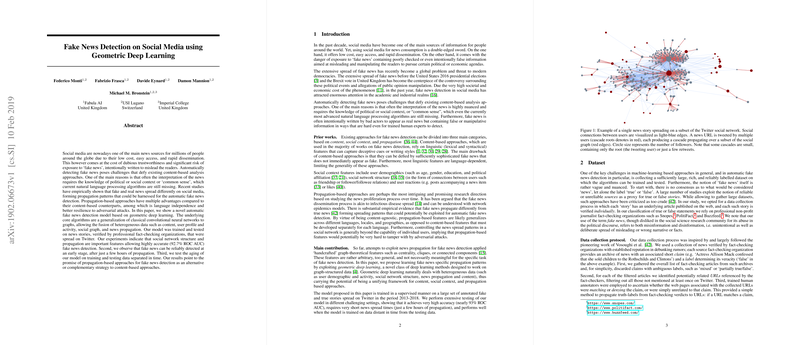Geometric Deep Learning for Fake News Detection on Social Media
The utilization of social media for news consumption has become increasingly widespread, presenting unique challenges in ensuring the credibility of disseminated content. This paper introduces a novel strategy for automatic fake news detection, employing geometric deep learning to leverage the distinct propagation patterns characteristic of fake news on social media platforms such as Twitter.
Approach and Methodology
The authors propose a propagation-based model, diverging from traditional content analysis. This model capitalizes on geometric deep learning, a sophisticated extension of convolutional neural networks (CNNs) to graph-structured data. Such an approach facilitates the integration of diverse data types, including user profiles, social network structure, and the dynamic spread of information. This model stands to benefit from being robust to adversarial manipulation and is inherently language-agnostic, which broadens its applicability across different user demographics and linguistic landscapes.
The paper harnesses empirical observations that fake and real news exhibit disparate propagation dynamics on social media. These dynamics are conjectured to resemble network epidemics in their dissemination patterns. With the dataset comprising stories verified by fact-checkers such as Snopes, PolitiFact, and Buzzfeed, the authors ensure the integrity of the data used for model training and validation.
Dataset and Features
The dataset contains 1,084 labeled claims and covers a vast network of 202,375 users connected by 2,443,996 social links. It represents both true and fake news items propagated on Twitter. Features extracted for analysis include user profile attributes, activity metrics, social network configurations, tweet content, and news spread pathways. This multifaceted data enables the model to analyze propagation within social networks from multiple angles.
Experimental Insights
The paper's findings assert the effectiveness of the geometric deep learning model, achieving an impressive 92.7% ROC AUC in URL-wise fake news detection. Importantly, the results indicate that fake news can be accurately detected even at early stages of propagation, suggesting temporal robustness of the model. The ability to identify misinformation early in its dissemination curve provides a crucial opportunity for mitigating its potential impact on public opinion and societal discord.
Implications and Future Work
The successful deployment of geometric deep learning in this context showcases the potential of propagation-based methods as either an alternative or complementary strategy to content-based approaches. This method not only broadens the scope of fake news detection across different languages and regions but also promises enhanced resilience against tactics employed by perpetrators to disguise misinformation.
Looking forward, the extension of this model to other social media and content-sharing platforms could be pivotal. Future research could further refine this approach by incorporating real-time data processing capabilities and expanding to multilingual datasets. Additionally, the ethical considerations of user privacy and data handling will continue to be a critical aspect to address as the technology develops.
Overall, the paper marks a significant advancement in the domain of fake news detection, offering a scalable and adaptable framework capable of confronting the nuanced challenges posed by misinformation on social media.
